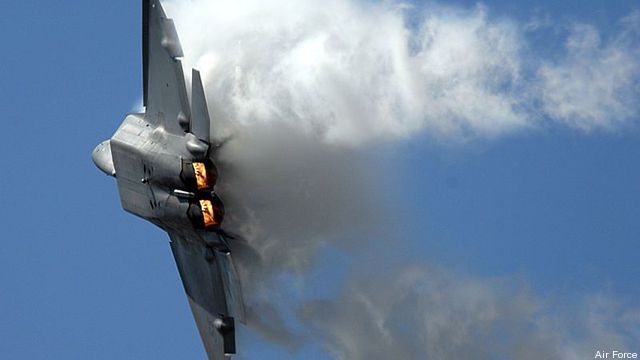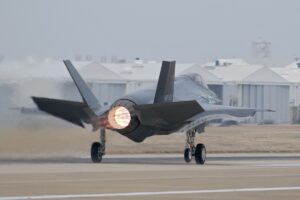
F-22 Raptor in flight.
PENTAGON: Restarting the F-22 line would probably be “cost-prohibitive,” says Air Force Secretary Deborah Lee James.
The idea for restarting the F-22 line was pushed hard by Rep. Randy Forbes, the outgoing chairman of the House Armed Services seapower and projection forces subcommittee. Forbes was defeated by Scott Taylor, a relatively unknown challenger, a Virginia state delegate who is a former Navy SEAL.
Meanwhile, James notes during an interview in her E ring office with gorgeous views of the Washington Monument, the service is pressing ahead with its Air Superiority 2030 study to limn the first thoughts on what a sixth-generation fighter or system of systems will be. Things have changed since the F-22 was first designed in the late 1980s. The threat is “arguably different” from when the F-22 was conceived, James says, emphasizing that it is a “great aircraft” and has proven useful in ways that were not foreseen when it was designed.

The Air Force has staked its future on the F-35.
Former Air Force Chief of Staff Mark Welsh recently had expressed openness to the idea of restarting the line, while citing many of the same strengths and weaknesses James did of the case to restart the plane. “I don’t think it’s a wild idea. I mean, the success of the F-22 and the capability of the airplane and the crews that fly it are pretty exceptional. I think it’s proven that the airplane is exactly what everybody hoped it would be,” Welsh said in late May.
There’s been considerable discussion as to where the idea to restart the F-22 line came from. All indications are that it was not Lockheed Martin, who see the F-35 Joint Strike Fighter as much of the company’s bread and butter for much of the next decade — at least. The House installed language in its version of the National Defense Authorization Act telling the Air Force secretary to conduct a study of the costs associated with procuring at least another 194 F-22s by Jan. 1. But restarting production would costs tens of billions of dollars that the Air Force would have to take from other pots — all while the service juggles how to cope with the still impending threat of sequestration from the Budget Control Act.
Navy jet trainer fleet operations remain paused after engine mishap
One week after the incident, a Navy spokesperson says the service is continuing to assess the fleet’s ability to safely resume flight.


























